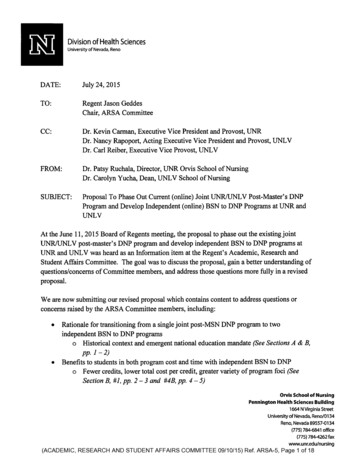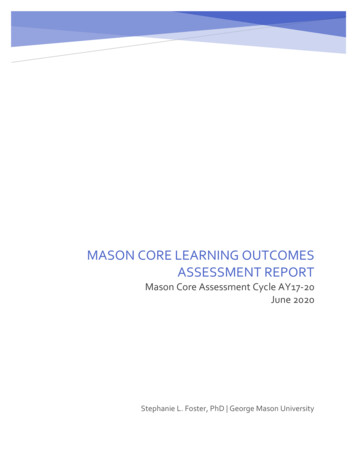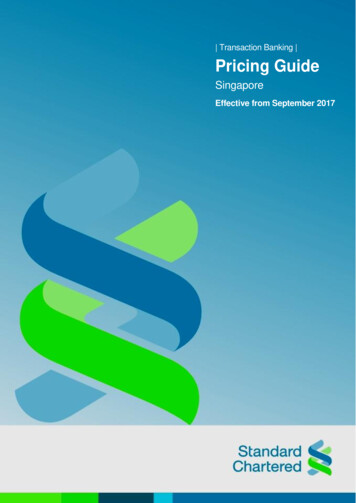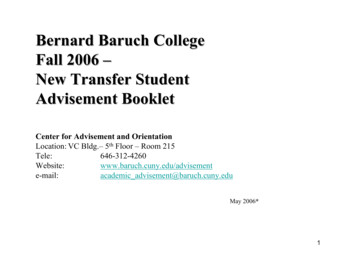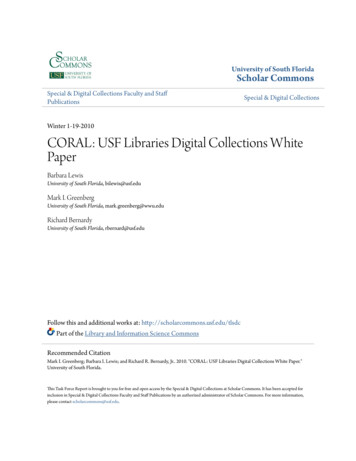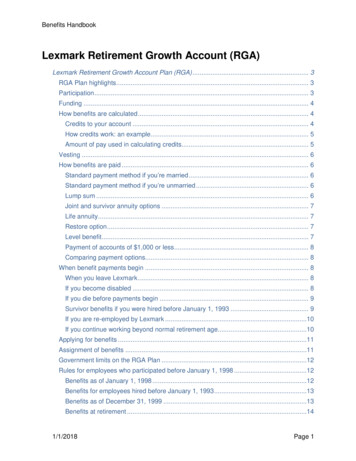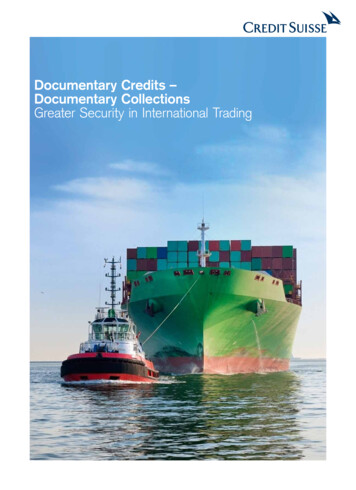
Transcription
Documentary Credits –Documentary CollectionsGreater Security in International Trading
Contents1.Risk and Security in International Trade2.A.B.Instruments for Securing PaymentDocumentary CreditsDocumentary Collections3.Case Study and Countertrade4.AppendixList of TermsIndexList of FiguresBibliographyFor simplicity, masculine forms are used to designate both gendersthroughout this text.313 / 79158193103
AbbreviationsAGStock corporationArt.ArticleBGE Swiss Federal Supreme Court ruling, Official collection of judgments by theSwiss Federal Supreme Court, Lausanne 1875 et seq.2CFRCost and freightCIFCost, insurance and freightCSCredit SuisseEFTAEuropean Free Trade AssociationEUEuropean UnioneUCPSupplement to UCP 600 for electronic presentation (English only)Fig.FigureFOBFree on boardICCInternational Chamber of CommerceISP98International Standby Practices 98L/CLetter of creditLtd.Limited companySCOSwiss Code of ObligationsUCPUniform Customs and Practice for Documentary CreditsURCUniform Rules for Collections
1. Risk and Security in International TradeA.Operating Environment5B.Risks6C.Protection against Risks7D.Instruments for Securing Payment: an Overview1. Documentary Credits2. Documentary Collections3. Payment Guarantees991010E.Bank Guarantees as Protection against Non-Performance11F.Disputes Related to ICC Instruments113
Risk and Security in International Trade1. Risk and Security in International TradeA. Operating EnvironmentSwitzerland has few natural resources and only a relatively smalldomestic economy. However it benefits from a high degree ofindustrial specialization and a well-developed services sector. Allthis means that the Swiss economy is extremely dependent onforeign trade. In 2006, for example, exports of goods and services accounted for no less than 54 % of GDP, while importswere also very high at 46 %. This reliance on international tradebrings both risks and opportunities. On the one hand, it makesit easier for Switzerland to access new markets, on the other itleaves Swiss businesses more exposed to tougher internationalcompetition and increases dependence on global economicactivity.In the past few decades, ongoing globalization has led to animprovement in general prosperity and a shift in the economicoperating environment. Foreign trade has been boosted, thusextending the international division of labor. The result has beengreater specialization of value creation in areas of productionwith a comparative advantage. For producers and consumers,closer integration and worldwide interdependence of marketshave opened up the possibility of better exploiting economies ofscale. In addition, productivity-enhancing investments and innovations have been encouraged. More intense competition isreducing profit mark-ups, and causing sources of economicinefficiency to dry up. In this “new” world, only high-performancecompanies can survive.New developments, particularly in technology and telecommunications, mean that the utopia of a “global village” is increasingly becoming reality and intensifying the “war for talent”.Because there is also greater insecurity in the world, thesechanges are accompanied by a considerable potential for conflict. As new markets emerge and open up in Eastern Europe,Asia and Latin America, new opportunities for growth are presenting themselves to innovative, flexible companies and to theworld economy as a whole. Consequently, the demand for international trade finance and project finance is also rising.An important complement to the free trade agreement of 1972are the seven bilateral agreements between Switzerland and theEuropean Union that entered into force in mid-2002. As a result,the free movement of persons was introduced between Switzerland and the EU-17 / EFTA on June 1, 2007. This creates abetter operating environment for Swiss companies with strongeconomic ties and interests in Europe. For export companies,estimating and hedging against currency fluctuation betweenthe franc and the euro is a central challenge. There is still a greatneed for payment and performance guarantees for business inless well-known and higher-risk markets outside the EU.5
Risk and Security in International TradeB. RisksMany of the trends outlined above involve heightened risks forexporters. From their point of view, security of payment hastherefore become increasingly important. At the same time, theyare encountering a greater awareness of risk among theirbuyers. They often have to provide far-reaching guarantees oftheir willingness and ability to meet contractual commitments.Otherwise they will not even be considered for the contract.This even applies to Swiss importers, whose impeccable payment record used to be regarded as sufficient security. Theirsuppliers want assurances of their willingness and ability to meettheir financial obligations. Suppliers’ insistence on security ofpayment can result in complicated formalities that conflict withthe importer’s desire to receive the goods in perfect conditionand without delay.Trading firms that act as middlemen are concerned with bothsides of the problem. In addition, they sometimes have to provide short-term financing for consignments in transit, i.e. theyhave to pay the supplier, or provide an assurance of payment,before receiving payment from the buyer.The risk of loss in an international transaction relates partly tothe possible behavior of the other contracting party and partly tothe political and economic situation in the foreign country orcountries concerned. The same types of risk have differentcauses, depending an whether they involve the buyer or theseller. The following tables provide an overview of the varioustypes of risk and the most important possible causes ofloss.Risks Relating to the Contracting Party (Fig. 1)Type of RiskCredit (del credere) riskCause of Loss to the ExporterBuyer unable or unwilling to payManufacturing or performance riskImporter cancels or unilaterally modifiesthe orderto the ImporterExporter unable or unwilling to refundadvance paymentsExporter unable to execute the contractfor technical or financial reasonsExporter unwilling to perform under thecontractRisks Relating to the Economic and /or Political Situation in the Country of the Contracting Party or in OtherCountries (Fig. 2)Type of RiskPolitical riskTransfer riskExchange risk6Cause of Loss to the ExporterImporter prevented by political events orofficial actions (war, revolution, importbans, confiscation, etc.) from carryingout his side of the contractGovernments or other public sectorentities refuse or are unable to makepayment in the agreed currency(moratorium)Contract currency depreciates againstexporter’s currencyto the ImporterExporter prevented by political events orofficial actions (war, revolution, embargoes, etc.) from carrying out his side ofthe contractGuarantee payments or refunds ofadvance payments rendered impossibleContract currency depreciates againstimporter’s currency
Risk and Security in International TradeC. Protection against RisksThe risks involved in international trade have to be carefullyassessed. This is no easy matter, especially in the case of majorcontracts that run over several years, e.g. large-scale construction projects or contracts for the purchase of industrial machinerywith long manufacturing times. Banks have vast practical experience in this field and can therefore make an important contribution to the smooth execution of international transactions,whether these are straightforward or more complex. When planning and negotiating big projects, it is therefore advisable to callin a competent bank at an early stage.If the buyer and seller are both Swiss, each party can usually bereasonably sure that the other will meet its obligations. It is aneasy matter to check up on the other party’s creditworthinessand business reputation. Moreover, any legal proceedings ordebt collection measures will come within the jurisdiction of thecourts and authorities of the country concerned. Domestictransactions are therefore normally settled on “open account”,i.e. the seller presents his invoice only after the goods or services have been supplied.When doing business with less well-known foreign firms, a contract of sale does not always provide the same sound and reliable basis as it does in the domestic market. In fact, the securityprovided by a simple contractual undertaking on the part of aforeign company can only be considered adequate if the partieshave a long-standing business relationship or a strong commoninterest (e.g. financial ties). Stable political, economic and legalconditions in the foreign country are also a necessary prerequisite. Otherwise, both parties will want additional security.Securing Payment (Fig. 3)The aim is to ensure prompt payment for goods or services.These instruments therefore serve primarily to protect the interests of the seller / exporter.ImporterBuyerBank pays whengoods /services aresupplied and debitsthe importer (buyer)Goods /servicessuppliedExporterSeller7
Risk and Security in International TradeSecuring Peformance (Fig. 4)The aim is to ensure performance of the contract by the seller.These instruments protect the interests of the buyer / importer.ImporterBuyerThe buyer’s and seller’s ability to insist on effective securityarrangements will depend largely on the two parties’ respectivenegotiating strength. This depends in turn on their relative market positions.For example, a confirmed irrevocable documentary credit provides the seller with an assurance that he will be paid promptlyagainst presentation of the correct documents. The advantagesfor the buyer, however, are less clear. Indeed, from his point ofview, a documentary credit has a number of disadvantages: Heusually bears the cost of the documentary credit.is obliged to make payment as soon as the correct documents are presented to his bank, whereas the seller is atliberty to present the documents or not and is therefore freeof any obligation until the moment he avails himself of thecredit. A documentary credit ensures that payment will be made onlyagainst the stipulated documents, but it offers no guaranteethat the goods will be delivered or the service rendered inaccordance with the terms of the contract. HeGoods /servicesnot suppliedBank pays whengoods /services arenot supplied anddebits the exporter(seller)ExporterSellerA buyer is therefore unlikely to apply for a documentary crediton his own initiative. As a rule, he will only agree to this methodof payment if the seller demands it and if there is no other equallygood supplier who does not. This is what happens in a seller’smarket and it is in practice a rare occurrence.In this kind of market, sellers do not need to worry about findingbuyers, which means that they are in a strong position (e.g. amonopoly). They can therefore demand maximum security ofpayment (e.g. a documentary credit opened by the buyer).The buyer’s need for security depends on the conditions ofcontract relating to the seller’s obligations. If he is the sole buyerand can choose between a number of suppliers, he will be ableto obtain the security he wishes in almost every case. This isthe situation in a pure buyer’s market.In this kind of market, the buyer is in a strong position andcan therefore demand the highest possible security (e.g. abank guarantee from the seller).The banks offer a wide range of instruments designed to meetthe differing security needs of buyers and sellers. Each casehas to be examined on its merits in order to ascertain whichinstruments are necessary and appropriate. In practice, somesort of balance is usually struck between the interests of thetwo parties. Instruments for protecting the interests of buyersand sellers can then be used in combination, as outlined inChapter 3.The following two sections summarize the principal servicesoffered by the banks in this connection.8
Risk and Security in International TradeD. Instruments for Securing Payment: an OverviewThe two principal instruments offered by the banks for executingand securing payments in international trade are documentarycredits and documentary collections. In certain circumstances, a seller’s right to receive the agreed price can also beprotected by means of a payment guarantee.1.Another mechanism available to exporters is forfaiting, a nonrecourse financing transaction. Forfaiting performs a usefulpayment-securing function, but it is first and foremost a financingtechnique and therefore does not fall within the scope of thisbrochure. Nor shall we consider state-run schemes for insurance against trade risks (export risk guarantees).Documentary CreditsA documentary credit is an undertaking made by a bank, either at the request of the applicant for the credit or on itsown behalf, to pay a specified amount in an agreed currency to a beneficiary, on condition that the beneficiary presentsstipulated documents within a prescribed time limit.In most cases, the bank acts as an intermediary between thebuyer and the seller. However, subject to the applicable nationallegislation, banks may also issue documentary credits on theirown account. Settlement of documentary credits is effectedthrough the bank by means of a direct exchange: the beneficiarypresents the required documents to the bank and receives inreturn the amount specified in the credit (in the form of cash, anaccepted bill of exchange or an undertaking to pay, dependingon the terms of the credit). With a documentary credit, thebeneficiary is no longer dependent on the buyer’s ability or will-ingness to pay. Moreover, he can obtain liquid funds shortly afterdispatching the goods.Documentary credits go a long way toward reconciling the conflicting interests of the buyer and the seller: The seller wants to be sure that the price of the goods willbe paid in the correct currency. The buyer does not want to pay for the goods before theyhave actually been dispatched.9
Risk and Security in International Trade2.Documentary CollectionsIn a documentary collection, a bank collects payment for the seller by delivering documents to the buyer.Here again, the bank acts as an intermediary between the buyerand the seller. In this case, however, the seller does not receivepayment until the monies have been paid to the remitting bank.He therefore has to wait longer for his money than if he werebeing paid under a documentary credit. Moreover, his risk is notfully covered. When he sends off the goods, he still has noassurance that the buyer or the buyer’s bank will pay; he simplyhas to trust in their ability and willingness to do so. Documentarycollections are therefore normally used only when the buyer andseller are already familiar with each other.Documentary Credits and Documentary Collections both Have Their Specific Advantages (Fig. 5)Documentary Credit Can 3.be used as a means of securing payment in transactions with virtually every country in the world.Rapid access to funds for the seller.Flexible terms of payment with no impairment of security.Suitable as an instrument for short-term financing. Rapid and convenient settlement, often enabling the sellerto offer attractive discounts.High degree of legal security throughout the world.Payment GuaranteesA payment guarantee serves to protect claims arising from aloan or from some other financial liability. If a buyer unexpectedlyfails to make payment when the exporter has met his contractual obligations (i.e. has delivered the goods or performed theservice as agreed), a written declaration to this effect is sent to10Documentary Collections Substantially better security than settlement on openaccount. Usually faster than settlement on open account (becausethe documents are presented through a bank). Where documents are to be released against acceptanceof the bill of exchange in Switzerland, the seller can requestan official confirmation in the event of non-payment (protest). This speeds up recovery of the debt and simplifies thecollection of interest on arrears. Few formal requirements, hence great flexibility for bothbuyers and sellers. Low cost.the guarantor bank, which will then be obliged to pay. This isquite distinct from the more usual function of a bank guarantee,which is to ensure that the seller carries out his side of the contract. Please also refer to the brochure on bank guarantees.
Risk and Security in International TradeE.Bank Guarantees as Protection against Non-PerformanceBank guarantees are easily the most important instruments forprotecting buyers against non-performance of international contracts. The usual form of guarantee is complementary to, butlegally independent of, the underlying commercial contract. Thebank undertakes to pay the buyer a definite sum of money if theseller fails to meet his contractual obligations. Guarantees ofF.this type have become a very important feature of internationaltendering. Foreign buyers now demand guarantees againstmany kinds of risk, especially in the case of major projects. Themost commonly sought types of guarantee are tender bonds,performance bonds and advance payment guarantees. Pleasealso refer to the brochure on bank guarantees.Disputes Related to ICC InstrumentsIf the parties disagree about the interpretation of the definitionsor of the guidelines set down by the International Chamber ofCommerce with respect to documentary credits (UCP), documentary collections (URC) and demand guarantees (URDG),there are a number of different ways of settling the dispute. Thesimplest and undoubtedly cheapest method consists of constructive negotiation with the counterparty to find an acceptablesolution.If this is not successful, an appeal is made to a judge. This cantake place in a court of arbitration or in any other court. Suchcases usually take a long time. They require consultation andthe use of lawyers, which leads to high costs that often exceedthe value of the matter under litigation.The International Chamber of Commerce has set up an instrument and rules to solve disputes in a relatively amicable mannerin a similar way to in a court of arbitration. These rules – the ICCRules for Documentary Instruments Dispute Resolution Expertise (ICC DOCDEX RULES) – exist solely in English.The initiator can apply to the International Chamber of Commerce for a DOCDEX decision. The counterparty receives acopy of the application and can, but does not have to, state itsposition in reply. Three people are selected from a list of expertsin the International Chamber of Commerce’s Banking Commission to judge the case. The experts must declare their impartiality. The whole process should normally not take more than90 days from the arrival of the application at the InternationalChamber of Commerce to the issue of a DOCDEX decisionreached collectively by the experts. The costs amount to USD5,000 –10,000. If the case is unusually demanding, additionalcosts may be incurred. Over 270 cases have already been settled in this way since 1997.11
12
Risk and Security in International Trade2. Instruments for Securing PaymentA.Documentary Credits151.Procedures and Participants152.Basis in Law183.3.1The Documentary Credit AgreementBasic Forms of Documentary Credita) Unconfirmed Irrevocable Creditb) Confirmed Irrevocable Credit3.2Types of Credit and Special Arrangementsa) Overviewb) Types of Documentary CreditSight CreditDeferred Payment CreditAcceptance CreditNegotiation CreditRed Clause CreditRevolving CreditStandby CreditTransferable Creditc) Special ArrangementsBack-to-Back CreditAssignment of the Proceeds of a Documentary 4.3Issue of the CreditDocumentary Credit ApplicationNotification of the Issue of the CreditAdvice or Confirmation to the Beneficiary394247475.5.15.35.4Utilization of the CreditBasic principlesa) Compliance with Documentary Requirementsb) Compliance with Time LimitsDocumentsa) Overviewb) Documents of Titlec) Documents of Evidence and Accompanying DocumentsDiscrepancies in the t to UCP 600 for Electronic Presentation767.Costs775.213
Instruments for Securing Payment2. Instruments for Securing PaymentA. Documentary Credits1.Procedures and ParticipantsDocumentary credits are probably still the most versatile andeffective means of securing payment in international trade.When doing business with countries where foreign trade isunder state control, it is often impossible to carry out import andexport transactions without the use of documentary credits.As well as providing security of payment, documentary creditscan also serve as a means of raising finance. A seller who hasa payment undertaking from the buyer’s bank is in a better position to request a loan from his own bank, e.g. to cover the costof producing the goods. The importer’s bank, too, may be pre-pared to grant a loan on the strength of a documentary credit ifthe handling of the credit will put it in possession of documentsof title to the goods. As a bill of lading or warehouse keeper’swarrant incorporates an entitlement to specific goods, possession of the document gives the bank ownership of the goodsthemselves.Although documentary credits are now increasingly being usedin connection with service transactions (including turnkeyprojects), here we are concerned primarily with their traditionalfunction as a means of securing payment for goods.Stages in a Documentary Credit Transaction (Fig. 6)Stage 1OfferThe exporter makes an offer to a prospective buyer.Documentary Credit AgreementIn contract negotiations, the exporter and the buyer agree onthe terms and conditions of the documentary credit.Stage 2OrderThe importer places an order with the exporter or signs acontract of sale.Issuing the Documentary CreditThe importer instructs his bank to issue the documentarycredit.Stage 3DeliveryThe exporter delivers the goods.Utilizing the Documentary CreditThe exporter obtains payment from the bank by presenting thedocuments stipulated in the agreement.15
Instruments for Securing PaymentParties to the Documentary Credit (Fig. 7)A straightforward documentary credit transaction involves threeparties: the applicant (buyer, importer) the issuing bank (issuing bank, buyer’s / importer’s bank) the beneficiary (seller, exporter)The issuing bank is usually located in the importer’s country,which could well be thousands of miles away from the countryof the exporter. This makes it very difficult for the exporter togauge the creditworthiness of the issuing bank. The transfer ofinformation and documents takes time and involves risks, whichis why a correspondent bank located in the same country oreven in the same town as the beneficiary is usually brought in asa fourth party to the transaction. This bank can reliably assessthe status of the issuing bank and also has rapid and dependable means of communication with it.a)b)Importer, buyerApplicantImporter, buyerApplicantIssuing bankIssuing bankCorrespondent bankExporter, sellerBeneficiary16Exporter, sellerBeneficiary
Instruments for Securing PaymentIf the importer already has a banking relationship in the exporter’s country, he can apply directly to that bank for the issue of adocumentary credit. This procedure is available, for example, toSwiss companies located abroad and provides them with a moredirect and economical way of paying for goods delivered fromSwitzerland.c)Importer, buyerApplicantIssuing bankExporter, sellerBeneficiary17
Instruments for Securing Payment2.Basis in LawDocumentary credits are not expressly mentioned in either theSwiss Code of Obligations or other Swiss legislation. Legaljudgments in relation to documentary credits were formerlybased exclusively on the relevant articles of the Swiss Code ofObligations, i.e. Articles 394 et seq. (“Mandate”) and Articles466 et seq. (“Order”).In a judgment made in 1952 (BGE 78 II 42 et seq. [1952]), theSwiss Federal Supreme Court ruled for the first time that thelegal relationships between the parties to a documentary creditare also governed by the Uniform Customs and Practice forDocumentary Credits (UCP). The UCP are a set of internationally recognized definitions and rules for documentary creditoperations. They are issued by the International Chamber ofCommerce in Paris and are updated from time to time. Thelatest revision (UCP 600), in force since 2007, is reproduced inthe Appendix.In 2002, a “supplement for electronic presentation”, knownas the eUCP was added to the UCP 500. This supplement wasalso revised in 2007 in line with the new UCP 600. As the title3.of the supplement suggests, it sets down definitions and rulesof conduct related to the presentation of electronic documents.These rules are also included in the Appendix.Today, all legally binding documents used by internationallyactive banks in connection with documentary credit transactionsstate that the credit is subject to the UCP. The UCP thus forman integral part of the contractual agreements between the parties to the credit.All Credit Suisse application forms for documentary credits orcorresponding electronic instructions carry the following text:“This documentary credit is to be subject to the “Uniform Customs andPractice for Documentary Credits” published by the International Chamberof Commerce in force at the time of the issuance”.However, the parties to a documentary credit are also entitled tomake agreements that deviate from the UCP in specific points(UCP, Art 1).The Documentary Credit AgreementAn export company has been asked by a prospective foreign buyer to submit an offer for the supply of goods orservices.When submitting the offer or signing the contract of sale, theseller must already have a clear idea of the risks and requirements involved, i.e. in relation to the credit standing and trustworthiness of the buyer the political, economic and legal situation in the buyer’scountry his own liquidityIf a documentary collection is out of the question, the seller willselect one of two basic forms of documentary credit,depending on the level of security needed: unconfirmed irrevocable credit confirmed irrevocable credit18In order to avoid hitches in the documentary credit transaction,the seller should also have precise ideas regarding the followingpoints: type of credit or special arrangement (see summary on page38, Fig. 16) period of validity mode of transport and route insurance cover delivery terms (FOB, CFR, CIF, etc.), etc.These points will also affect the exporter’s price calculation, aswill the cost of any banker’s guarantees issued in favor of thebuyer.
Instruments for Securing PaymentAs mentioned above, the terms and conditions of the documentary credit should be set out in the agreement as the seller canstill influence the contents of the documentary credit at thisstage. The documentary credit clause in the contract of sale notonly obliges the buyer to issue a documentary credit in favor ofthe seller but also obliges the seller to accept payment throughthe documentary credit provided.b) Confirmed Irrevocable CreditBy adding its confirmation to the credit, the correspondent bankundertakes to honour documents which conform to the terms ofthe credit and are presented within the prescribed time limit(UCP, Art. 2 definition of “Confirmation” and Art. 8). In this case,the beneficiary receives not only an undertaking by the issuingbank but also an independent promise of payment on thepart of the correspondent bank.3.1 Basic Forms of Documentary CreditThis significantly improves the beneficiary’s security. Confirmation by the correspondent bank eliminates the political andtransfer risks provided the beneficiary is domiciled in the samecountry as the confirming bank.Credit Documentary credits come in various basic forms. Thesediffer according to the degree of security provided and thepoint in time at which the bank assumes the risk.In the case of an irrevocable, unconfirmed letter of credit, theconsent of the beneficiary is required for any changes to, orcancellation of the credit. In the case of an irrevocable, confirmed letter of credit, the consent of the confiming bank is alsorequired.a) Unconfirmed Irrevocable CreditIn the case of an unconfirmed irrevocable credit, the correspondent bank merely advises the beneficiary that a documentary credit has been issued. It does not itself give anyundertaking to pay and is under no obligation to honour documents presented by the beneficiary.The beneficiary therefore has to rely solely on the foreign bankwhich issued the credit. This means that an unconfirmed irrevocable credit is appropriate only if the political and transfer risksare low. However, provided the correspondent bank has goodrelations with the issuing bank and the political and economicsituation in the foreign country is stable, the correspondent bankwill generally honour the documents in order to enable the clientto conclude the transaction promptly.Moreover, in case of dispute, the competent courts of the confirming bank’s country have exclusive jurisdiction, and the lawsof that country apply. Disputes relating to unconfirmed creditsare dealt with by the courts of the issuing bank’s country.From the exporter’s point of view, obtaining the jurisdiction of a court in hisown country can be very important. An example will illustrate this. A court ina developing country, disregarding the Uniform Customs and Practice forDocumentary Credits, ruled that the applicant for the credit had the right toreject irregular documents several months after receiving them, if at the timeof their receipt no adequately qualified staff were available to examinethem.A correspondent bank can have good reasons for refusing arequest to confirm a documentary credit. Before signing thecontract, export companies are well advised to find out fromtheir bank whether and on what conditions it will be prepared toconfirm a credit from
In this kind of market, sellers do not need to worry about finding buyers, which means that they are in a strong position (e.g. a monopoly). They can therefore demand maximum security of payment (e.g. a documentary credit opened by the buyer). The buyer's need for security depends on the conditions of contract relating to the seller's .

